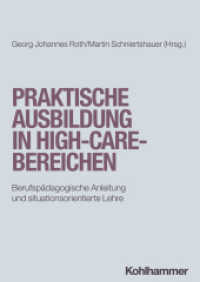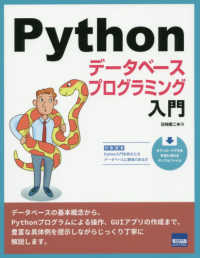- ホーム
- > 洋書
- > 英文書
- > Business / Economics
Full Description
Flexibleassemblysystems(FASs)haveemergedasaresultofthedevelop- mentsinmanufacturingandcomputertechnology. Currentmarketrequire- mentscharacterizedby -increasingnumberofdifferenttypesandversionsofproducts, -smallerbatchsizes,and -shorterlife-timeofproducts, stronglydeterminethecompetitivenessinproductionassemblyandaddi- tionallycontributetothedevelopmentofflexibleautomatedassembly. For example,attheendof1986[33]40%ofJapaneserobotswerespecialized inassemblyascomparedwithonly10%ofEuropeanrobots. Theremain- ing90%wereusedinwelding,painting,andhandling. Theintroductionof flexibleautomatedassemblytohigh-techsectorswhereassemblycostsare criticalistheaimofmajorEuropeanprojectssuchasESPRITandBRITE programmesandtheFAMOS-EUREKAproject,e. g. ,[33,34]. Thebookdealswithproductionplanningandschedulinginflexibleassem- blysystems. ThereaderisfamiliarizedwiththeFASplanningandschedul- ingissuesforwhichvariousoperationsresearchmodellingandsolutionap- proachesarediscussed. Inparticular,applicationsofintegerprogrammingto theFASshort-termplanningandfastcombinatorialheuristicstotheFAS schedulingarediscussed. Thematerialinthebookhasbeendividedintosevenchapters.
Chapter1presentstheoverallstructureandhardwarecomponentsand featuresofaflexibleassemblysystem. TheFASsclassificationisprovided andillustratedwithindustrialapplicationsofmechanicalpartassemblyand printedcircuitboard(PCB)assembly. Chapter2discussesmajorissuesinthedesign,planningandschedulingof flexibleassembly. BasicconfigurationsofFASsandmaterialflownetworksare presentedandvariousapproachestodesignforautomatedassemblyandto assemblyplanningarediscussed. TheFASproductionplanningandschedul- ingareconsideredwithinahierarchicalframeworkwithmachineloadingand assemblyroutingatanupperlevelandmachineandvehicleschedulingata lowerlevel. Finally,specificissuesinplanningandschedulingofPCBassem- blyarediscussed. VIII Preface InChapter3variousbi-objectiveintegerprogrammingmodelsandso- lutionapproachesarepresentedformachineloadingandassembly-routing inFASs. Aninteractiveprocedureisproposedforsimultaneousloadingand routingbasedonweightingapproachandalexicographicalgorithmisgiven forsequentialloadingandroutingwithalinearrelaxationloadingheuristic andanetworkflowroutingmodel. Numericalexamplesillustratepossible applicationsofthemodellingandsolutionapproachespresented.
InChapter4thesequentialmodellingandsolutionapproachproposedin Chapter3hasbeenextendedforabicriterionmachineloadingandassembly routingwithsimultaneousassemblyplanselectioninageneralFASandina flexibleassemblyline. Numericalexamplesareprovidedtoillustratepossible applicationsoftheapproachproposed. Chapter5presentsmathematicalprogrammingformulationsforsimul- taneousloadingandschedulinginflexibleassemblycells. Theformulations areillustratedwithpracticalapplicationsinmechanicalpartassemblywith arobotassemblycellandinPCBassemblyonacomponentplacementma- chine. Chapter6isdevotedtoproductionschedulinginflexibleassemblylines whereseveralassemblystagesinseriesareeitherseparatedbyfiniteinter- mediatebuffersortherearenobuffersbetweenthestages,andeachstage consistsofoneormoreidenticalparallelmachines. Fastpush-typeschedul- ingheuristicsareproposedforthelinewithlimitedintermediatebuffersor thelinewithnoin-processbuffers. Foracomparison,apull-typeschedul- ingstrategyisillustratedwithsomerecentresultsfortheJust-In-Timeand multilevelschedulingofflexibleassemblylines. Numericalexamplesprovide thereaderwithpossibleapplicationsofthevariousmodellingandsolution approachespresented.
InChapter7simultaneousschedulingofassemblystationsandautomated guidedvehiclesisdiscussedforageneralFASandtwodifferentsolutionap- proachesarepresented:(i)amulti-levelapproach,inwhichfirstmachine loadingandassemblyroutingproblemissolvedandthen,giventaskassign- mentsandassemblyroutesselected,detailedmachineandvehicleschedules aredetermined;(ii)asingle-levelapproach,inwhichmachineandvehicle schedulesaredirectlydeterminedwithnoinitialloadingandroutingdeci- mentscharacterizedby -increasingnumberofdifferenttypesandversionsofproducts, -smallerbatchsizes,and -shorterlife-timeofproducts, stronglydeterminethecompetitivenessinproductionassemblyandaddi- tionallycontributetothedevelopmentofflexibleautomatedassembly. For example,attheendof1986[33]40%ofJapaneserobotswerespecialized inassemblyascomparedwithonly10%ofEuropeanrobots. Theremain- ing90%wereusedinwelding,painting,andhandling. Theintroductionof flexibleautomatedassemblytohigh-techsectorswhereassemblycostsare criticalistheaimofmajorEuropeanprojectssuchasESPRITandBRITE programmesandtheFAMOS-EUREKAproject,e. g. ,[33,34]. Thebookdealswithproductionplanningandschedulinginflexibleassem- blysystems.
ThereaderisfamiliarizedwiththeFASplanningandschedul- ingissuesforwhichvariousoperationsresearchmodellingandsolutionap- proachesarediscussed. Inparticular,applicationsofintegerprogrammingto theFASshort-termplanningandfastcombinatorialheuristicstotheFAS schedulingarediscussed. Thematerialinthebookhasbeendividedintosevenchapters. Chapter1presentstheoverallstructureandhardwarecomponentsand featuresofaflexibleassemblysystem. TheFASsclassificationisprovided andillustratedwithindustrialapplicationsofmechanicalpartassemblyand printedcircuitboard(PCB)assembly. Chapter2discussesmajorissuesinthedesign,planningandschedulingof flexibleassembly. BasicconfigurationsofFASsandmaterialflownetworksare presentedandvariousapproachestodesignforautomatedassemblyandto assemblyplanningarediscussed. TheFASproductionplanningandschedul- ingareconsideredwithinahierarchicalframeworkwithmachineloadingand assemblyroutingatanupperlevelandmachineandvehicleschedulingata lowerlevel. Finally,specificissuesinplanningandschedulingofPCBassem- blyarediscussed. VIII Preface InChapter3variousbi-objectiveintegerprogrammingmodelsandso- lutionapproachesarepresentedformachineloadingandassembly-routing inFASs.
Aninteractiveprocedureisproposedforsimultaneousloadingand routingbasedonweightingapproachandalexicographicalgorithmisgiven forsequentialloadingandroutingwithalinearrelaxationloadingheuristic andanetworkflowroutingmodel. Numericalexamplesillustratepossible applicationsofthemodellingandsolutionapproachespresented. InChapter4thesequentialmodellingandsolutionapproachproposedin Chapter3hasbeenextendedforabicriterionmachineloadingandassembly routingwithsimultaneousassemblyplanselectioninageneralFASandina flexibleassemblyline. Numericalexamplesareprovidedtoillustratepossible applicationsoftheapproachproposed. Chapter5presentsmathematicalprogrammingformulationsforsimul- taneousloadingandschedulinginflexibleassemblycells. Theformulations areillustratedwithpracticalapplicationsinmechanicalpartassemblywith arobotassemblycellandinPCBassemblyonacomponentplacementma- chine. Chapter6isdevotedtoproductionschedulinginflexibleassemblylines whereseveralassemblystagesinseriesareeitherseparatedbyfiniteinter- mediatebuffersortherearenobuffersbetweenthestages,andeachstage consistsofoneormoreidenticalparallelmachines.
Fastpush-typeschedul- ingheuristicsareproposedforthelinewithlimitedintermediatebuffersor thelinewithnoin-processbuffers. Foracomparison,apull-typeschedul- ingstrategyisillustratedwithsomerecentresultsfortheJust-In-Timeand multilevelschedulingofflexibleassemblylines. Numericalexamplesprovide thereaderwithpossibleapplicationsofthevariousmodellingandsolution approachespresented. InChapter7simultaneousschedulingofassemblystationsandautomated guidedvehiclesisdiscussedforageneralFASandtwodifferentsolutionap- proachesarepresented:(i)amulti-levelapproach,inwhichfirstmachine loadingandassemblyroutingproblemissolvedandthen,giventaskassign- mentsandassemblyroutesselected,detailedmachineandvehicleschedules aredetermined;(ii)asingle-levelapproach,inwhichmachineandvehicle schedulesaredirectlydeterminedwithnoinitialloadingandroutingdeci- sionsrequired. Foreachapproachaschedulingalgorithmbasedondynamic complexdispatchingrulesisproposedandnumericalexamplesareprovided toillustrateandcomparethetwoschedulingapproaches. Thematerialpresentedinthebookisillustratedwithnumerousexamples, figuresandextensivetables.
Thereaderisprovidedwithdetailedmathemat- icalmodelsoftheFASplanningandschedulingproblemsanddescriptions ofthesolutionalgorithmsproposed. Theirapplicationsareillustratedwith manynumericalexamplesandresultsofvariouscomputationalexperiments withthemodelsandalgorithmsarereported. Preface IX Thebookisaimedprimarilyatstudentsandprofessionalsinproduction andoperationsmanagement,industrialandsystemsengineering,andauto- matedmanufacturing. Thisbookbenefitedfromnumerousdiscussionswithmycolleagues. Pro- fessorAndreasDrexlandDr. RainerKolischfromtheChristian-Albrechts UniversityofKieldeservespecialthanksforthecarefulreadingofvarious partsofthemanuscriptandtheirvaluablecomments. ThebookhasbeenpreparedwithpartialsupportbyKBNresearchgrant #8TllF01513,AGHgrant#10. 200. 10,andTEMPUS-PHAREproject #S_JEP-09434-95. TadeuszSawik DepartmentofComputerIntegratedManufacturing FacultyofManagement UniversityofMiningandMetallurgy Krakow,Poland TableofContents 1. FlexibleAssemblySystems-HardwareComponentsand Features...1 1. 1 BasiccomponentsofaFAS...1 1. 1. 1Robots...1 1. 1. 2 PeripheraJequipment...4 1. 2 Classificationof'flexibleassemblysystems 5 1. 3 Examplesofindustrialinstallations...8 1. 3.
1 Mechanicalassembly...8 1. 3. 2 Printedcircuitboardassembly...9 2. IssuesinDesign,PlanningandSchedulingofFlexible Assembly...17 2. 1 FASdesignissues...18 2. 2 Networkdesignformaterialflowsystems...22 2. 3 Designforassembly...27 2. 4 Assemblyplanning 30 2. 5 Planningandscheduling...32 2. 5. 1 Machineloadingandassemblyrouting...35 2. 5. 2 Machineandvehiclescheduling 37 2. 5. 3 Planningandschedulinginelectronicsassembly...38 3. LoadingandRoutingDecisionsinFlexibleAssembly Systems 41 3. 1 Descriptionofaflexibleassemblysystem...43 3. 2 Optimizationofstationworkloadsandproductmovements. . 44 3. 3 Designandbalancingofflexibleassemblylines...50 3. 4 Numericalexamples 52 3. 5 Simultaneousloadingandrouting 56 3. 5. 1 Problemformulations...56 3. 5. 2 Aninteractiveheuristicforloadingandrouting 60 3. 5. 3 Numericalexamples...61 3. 6 Sequentialloadingandrouting...68 3. 6. 1 Problemformulations...
Contents
1. Flexible Assembly Systems — Hardware Components and Features.- 1.1 Basic components of a FAS.- 1.2 Classification of flexible assembly systems.- 1.3 Examples of industrial installations.- 2. Issues in Design, Planning and Scheduling of Flexible Assembly.- 2.1 FAS design issues.- 2.2 Network design for material flow systems.- 2.3 Design for assembly.- 2.4 Assembly planning.- 2.5 Planning and scheduling.- 3. Loading and Routing Decisions in Flexible Assembly Systems.- 3.1 Description of a flexible assembly system.- 3.2 Optimization of station workloads and product movements.- 3.3 Design and balancing of flexible assembly lines.- 3.4 Numerical examples.- 3.5 Simultaneous loading and routing.- 3.6 Sequential loading and routing.- 4. Loading and Routing Decisions with Assembly Plan Selection.- 4.1 Simultaneous loading, routing and assembly plan selection in a general flexible assembly system.- 4.2 Simultaneous loading, routing and assembly plan selection in a flexible assembly line.- 5. Loading and Scheduling in Flexible Assembly Cells.- 5.1 Loading and scheduling in a robot assembly cell.- 5.2 Loading and sequencing in printed circuit board assembly.- 6. Production Scheduling in Flexible Assembly Lines.- 6.1 Flexible assembly line with limited intermediate buffers.- 6.2 Flexible assembly line with no in-process buffers.- 6.3 Global lower bounds for flexible flow lines with unlimited buffers.- 6.4 Just-in-time scheduling of flexible assembly lines.- 6.5 Multilevel scheduling of flexible assembly lines with limited intermediate buffers.- 7. Machine and Vehicle Scheduling in Flexible Assembly Systems.- 7.1 Dispatching scheduling.- 7.2 Machine and vehicle scheduling — a multi-level approach.- 7.3 Machine and vehicle scheduling — a single-level approach.- References.








